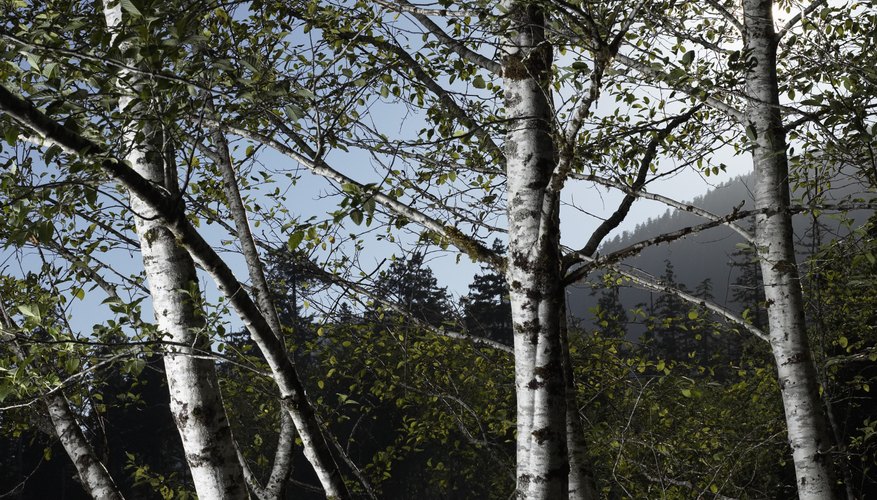Named after their attractive and unusual white bark, silver birch (Betula pendula) are elegant trees with a weeping habit that grow more than 12 metres (40 feet) tall. They can suffer from several diseases, characterised by cankers in bark, leaf spots, premature leaf fall and die back. Infections can sometimes kill seedlings but large trees are often able to withstand attack. Pruning out diseased areas and burning or disposing of infected material helps prevent the spread of disease.
Canker
Cankers -- rotting, open areas on tree trunks, branches and twigs -- can grow larger if left untreated, causing dieback in affected areas. Two fungi, Anisogramma virgultorum and Marssonina betulae, cause canker in silver birches. Marssonina betulae infects trees in spring and summer, causing leaf spots and cankers on shoots which can kill seedling trees. Anisogramma virgultorum causes cankers on stems and branches in late summer that die back the following year. Infections are thought to be spread by rainsplash from diseased material.
- Cankers -- rotting, open areas on tree trunks, branches and twigs -- can grow larger if left untreated, causing dieback in affected areas.
- Marssonina betulae infects trees in spring and summer, causing leaf spots and cankers on shoots which can kill seedling trees.
Leaf spot
Dead spots on silver birch leaves could be a sign of infection by the fungus Discula betulina. Appearing in early spring, severe infections can cause trees to lose their leaves prematurely and shoots to die back. Seedlings deliberately infected with this disease recovered fully, according to the Forestry Commission. Although not considered a serious disease of silver birches, Discula betulina's effects are increased if trees are stressed by other factors, such as drought or poor growing conditions.
- Dead spots on silver birch leaves could be a sign of infection by the fungus Discula betulina.
Rust
Rust is a common disease of garden plants. In silver birches it's caused by the fungus Melamsporidium betulinum. Rusty brown patches form on birch leaves and eventually turn into pustules that produce spores. Severely infected leaves die and fall prematurely. Control involves removing affected leaves and spraying with fungicide product containing chemicals such as difenoconazole or triticonazole. Small trees could be sprayed but rust diseases are unlikely to cause serious or permanent damage to healthy trees growing in suitable conditions.
- Rust is a common disease of garden plants.
- In silver birches it's caused by the fungus Melamsporidium betulinum.
Honey fungus
Silver birch roots can come under attack from honey fungus, species belonging to the genus Armillaria. Silver birch are particularly susceptible to honey fungus, which causes small leaves, premature leaf fall, cracked and bleeding bark at the base of the trunk, and dieback, especially during hot summer weather. Honey fungus mushrooms are also sometimes visible. Sheets of fine threads, called mycelium, appear between roots and bark and sometimes extend above ground, beneath the bark where the trunk meets the soil. Honey fungus is impossible to cure, and trees should be dug up and burnt to help prevent the spread of infection.
- Silver birch roots can come under attack from honey fungus, species belonging to the genus Armillaria.
- Silver birch are particularly susceptible to honey fungus, which causes small leaves, premature leaf fall, cracked and bleeding bark at the base of the trunk, and dieback, especially during hot summer weather.
